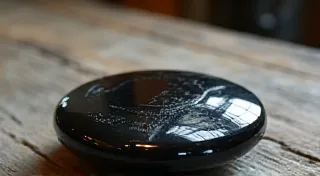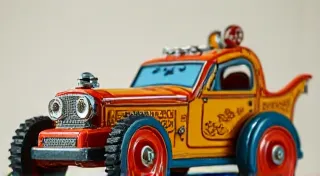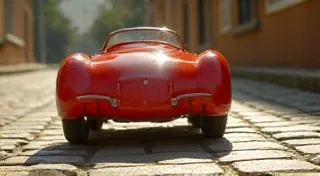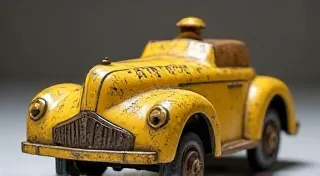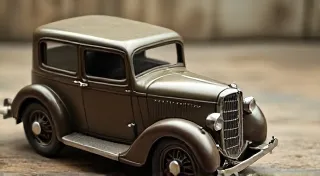The period between the two World Wars was a golden age for toy car production. Companies like Dinky Toys, Corgi, Lionel, and others were flourishing, creating intricate and desirable models that captivated children and, later, established the foundation for a vibrant collector's market. However, the outbreak of World War II fundamentally and dramatically altered the landscape of toy car manufacturing, creating shortages, prompting design adaptations, and ultimately shaping the types of vintage toy cars available to collectors today. This article will delve into the multifaceted ways the war impacted this beloved pastime.
The most immediate and significant impact of World War II on toy car production was the widespread rationing and severe shortages of raw materials. The war effort demanded almost all available resources – rubber, tinplate, lead, steel, and even paints – be diverted to military applications. This meant toy manufacturers faced immense difficulty securing the materials necessary to produce their models.
Rubber, crucial for tires on many toy cars, became almost impossible to obtain. Companies responded by drastically reducing the size of tires, sometimes eliminating them altogether and replacing them with solid plastic or bakelite substitutes. Tinplate, the primary material for most pressed steel toys, was heavily restricted. Lead, used for weights and some components, faced similar constraints. Even paints were affected, with vibrant colors often replaced by more muted and readily available tones. The quality of available materials often suffered as well, leading to thinner gauge tinplate and less durable plastics. This shift in materials often fundamentally altered the restoration process for collectors; understanding these differences is a key part of appreciating and maintaining vintage toy cars, as described in restoring vintage toy cars.
Beyond the primary materials, the war also impacted secondary components like springs, screws, and even the cardboard used for packaging. This resulted in simplified designs and a reduction in the overall quality and complexity of toy cars produced during the war years.
Image: 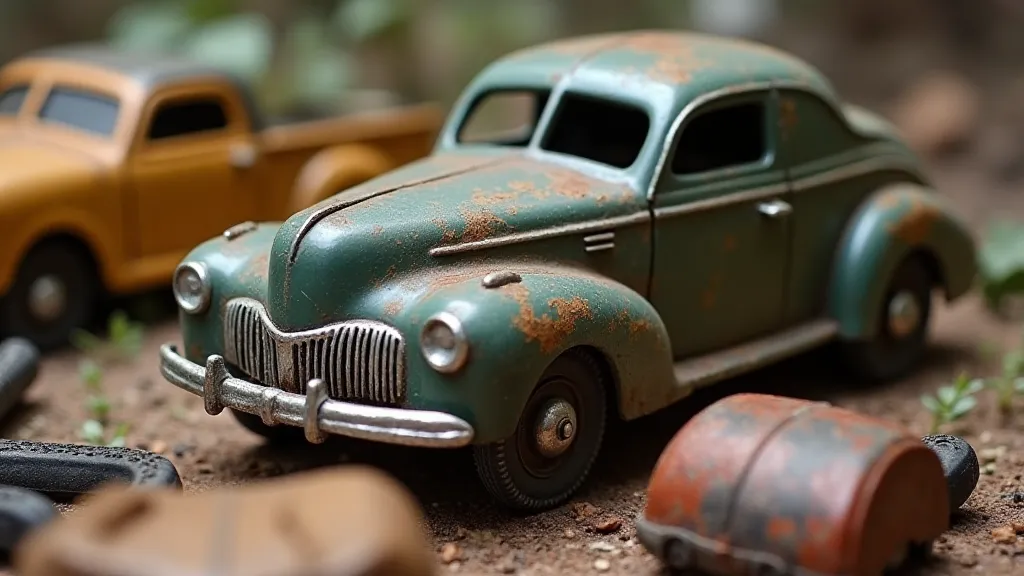
Faced with insurmountable material limitations, toy manufacturers had to become remarkably inventive. They embraced simplified designs, omitting intricate details that required more materials and labor. Many companies began producing “make-do” or “utility” models, utilizing whatever scraps and rejected materials they could find. These models were often less attractive and less durable than their pre-war counterparts, but they represented a crucial way to keep production lines moving and provide some form of entertainment for children.
One notable change was the shift away from elaborate, multi-part bodies to simpler, one-piece designs. Previously, many toy cars boasted intricate details like opening doors, hoods, and trunks. During the war, these features were largely eliminated to reduce the amount of tinplate required. Similarly, chassis designs were simplified and often less robust. The emphasis was on functionality and efficiency rather than aesthetic appeal. Collectors interested in understanding the historical context of these changes often delve into the broader history of toy construction and design, further exploring the intricate histories of iconic models in the history of cast iron toy cars. The impact of these restrictions wasn's just about material; it reshaped the entire approach to toy car design and manufacturing.
Another adaptation involved the use of alternative materials. Bakelite, a durable thermosetting plastic, became increasingly common as a substitute for metal components. While Bakelite offered a degree of resilience, it was often brittle and prone to cracking. Wood was also utilized, albeit less frequently, for wheels and other small parts.
The impact wasn't just about material. Design teams were often forced to use existing tooling and molds for new models, resulting in a blurring of model lines and some truly unusual combinations. It was a period of pragmatic engineering, driven by necessity rather than artistic vision. Often the most fascinating discoveries for collectors are those unexpected combinations resulting from these limitations.
The impact of the war varied significantly depending on the region of the world. In Allied countries like Britain and the United States, government restrictions and rationing were stringent. Toy production was often directly controlled or heavily influenced by the war effort. German and Japanese manufacturers, while initially able to maintain a higher level of production, ultimately faced the disruption of bombing raids and the loss of vital resources as the war progressed.
The British company Dinky Toys, for instance, severely curtailed its production and focused on producing items for the armed forces. Corgi Toys, a relatively new company at the time, was only able to begin limited production towards the end of the war, utilizing leftover materials and labor. In the United States, Lionel, a prominent manufacturer of model trains and toy cars, shifted its production entirely to military goods. The shifts in design and manufacturing often led to different grades of production and collectibility. The scarcity of materials led to a boom in the grey market, with black marketeers procuring and selling limited numbers of pre-war and wartime toy cars at inflated prices. The post-war era saw pent-up demand and a frenzied collecting of these scarce wartime treasures. Finding good deals in the current market demands both knowledge and patience – something that can be aided by understanding the principles of affordable collecting.
Beyond simply acknowledging the material shortages, the impact of the war profoundly altered the collecting landscape. These limited-run models, born of necessity and constraint, quickly became coveted prizes for enthusiasts. The heightened desirability often translated into significant value, transforming these once-functional toys into valuable artifacts.
Image: 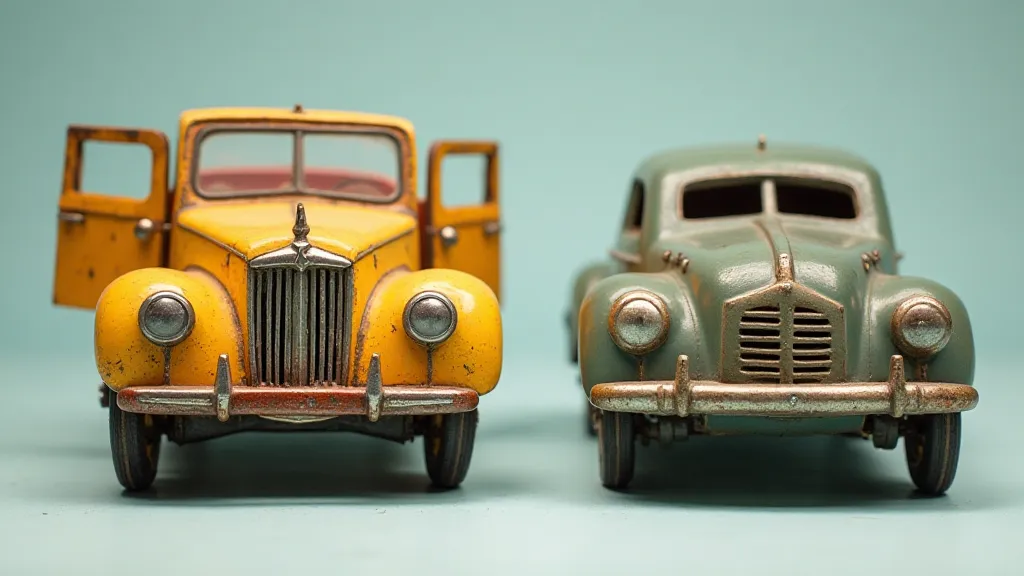
With the end of World War II, the toy car industry gradually revived. Material restrictions were lifted, and manufacturers were able to resume producing models closer to pre-war standards. However, the wartime experience left a lasting impact. The simplified designs and alternative materials used during the war became ingrained in the industry, influencing future model designs and contributing to the distinct character of wartime toy cars.
The scarcity of wartime models transformed them into highly sought-after collectibles. Their unique designs, the stories behind their production, and the challenges faced by manufacturers all contribute to their historical significance and their value in the collector’s market. Today, these “utility” or “wartime” models are considered some of the most interesting and historically important examples of vintage toy cars. The appeal of vintage cars transcends mere nostalgia, reflecting a broader fascination with automotive history and design; even the most dedicated collector understands the benefits of securing quality pieces within a budget. The burgeoning passion for these models has fueled a vibrant community of restorers, researchers, and enthusiasts.
The wartime period highlighted the resilience and ingenuity of toy manufacturers and demonstrated the ability of the industry to adapt to extraordinary circumstances. The legacy of these wartime toy cars is a testament to the human spirit's capacity for innovation and the enduring appeal of these miniature representations of the automobiles that shaped a generation. They serve as a poignant reminder of a period of hardship, resourcefulness, and the enduring power of play, even in the face of global conflict.
Image: 
Beyond the individual stories of specific models, the impact of the war on the toy car industry extends to the broader landscape of collecting. The increased desirability of certain models, coupled with the challenges of restoration, have fostered a vibrant community of enthusiasts, each contributing to the ongoing appreciation of these historical artifacts. For those drawn to the sleek lines and distinctive style of a particular era, the miniature representations offer a compelling avenue for exploring automotive history and design.
The impact of wartime limitations reverberates even today, influencing the design and desirability of many modern collectible toy cars. The pursuit of authenticity and historical accuracy has become a defining characteristic of serious collecting, elevating the appreciation of these miniature treasures. The enduring legacy of these constraints provides a fascinating window into the creative and resourceful efforts undertaken by toy manufacturers during a time of unprecedented global turmoil. This passion extends beyond mere accumulation; it's about understanding the historical context and appreciating the craftsmanship involved, mirroring the allure of the legendary Hot Wheels Redlines: The Legend and Legacy.
In conclusion, the wartime era left an indelible mark on the toy car industry, transforming production processes, design philosophies, and ultimately shaping the collecting landscape. These miniature representations offer a poignant reminder of a challenging period in history, celebrating the resilience of the human spirit and the enduring power of play.
